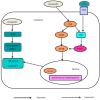The Potential Role of Gossypetin in the Treatment of Diabetes Mellitus and Its Associated Complications: A Review
- PMID: 38139436
- PMCID: PMC10743819
- DOI: 10.3390/ijms242417609
The Potential Role of Gossypetin in the Treatment of Diabetes Mellitus and Its Associated Complications: A Review
Abstract
Type 2 diabetes mellitus (T2DM) is a metabolic disorder caused by insulin resistance and dysfunctional beta (β)-cells in the pancreas. Hyperglycaemia is a characteristic of uncontrolled diabetes which eventually leads to fatal organ system damage. In T2DM, free radicals are continuously produced, causing extensive tissue damage and subsequent macro-and microvascular complications. The standard approach to managing T2DM is pharmacological treatment with anti-diabetic medications. However, patients' adherence to treatment is frequently decreased by the side effects and expense of medications, which has a detrimental impact on their health outcomes. Quercetin, a flavonoid, is a one of the most potent anti-oxidants which ameliorates T2DM. Thus, there is an increased demand to investigate quercetin and its derivatives, as it is hypothesised that similar structured compounds may exhibit similar biological activity. Gossypetin is a hexahydroxylated flavonoid found in the calyx of Hibiscus sabdariffa. Gossypetin has a similar chemical structure to quercetin with an extra hydroxyl group. Furthermore, previous literature has elucidated that gossypetin exhibits neuroprotective, hepatoprotective, reproprotective and nephroprotective properties. The mechanisms underlying gossypetin's therapeutic potential have been linked to its anti-oxidant, anti-inflammatory and immunomodulatory properties. Hence, this review highlights the potential role of gossypetin in the treatment of diabetes and its associated complications.
Keywords: diabetes mellitus; flavonoid; gossypetin.
Conflict of interest statement
The authors declare no conflict of interest.
Figures







References
-
- Federation I.D. At a Glance|119(3) Mar 2011. Environ. Heal. Perspect. 2011;119:a106–a109. doi: 10.1289/image.ehp.v119.i03. - DOI
Publication types
MeSH terms
Substances
Grants and funding
LinkOut - more resources
Full Text Sources
Medical

